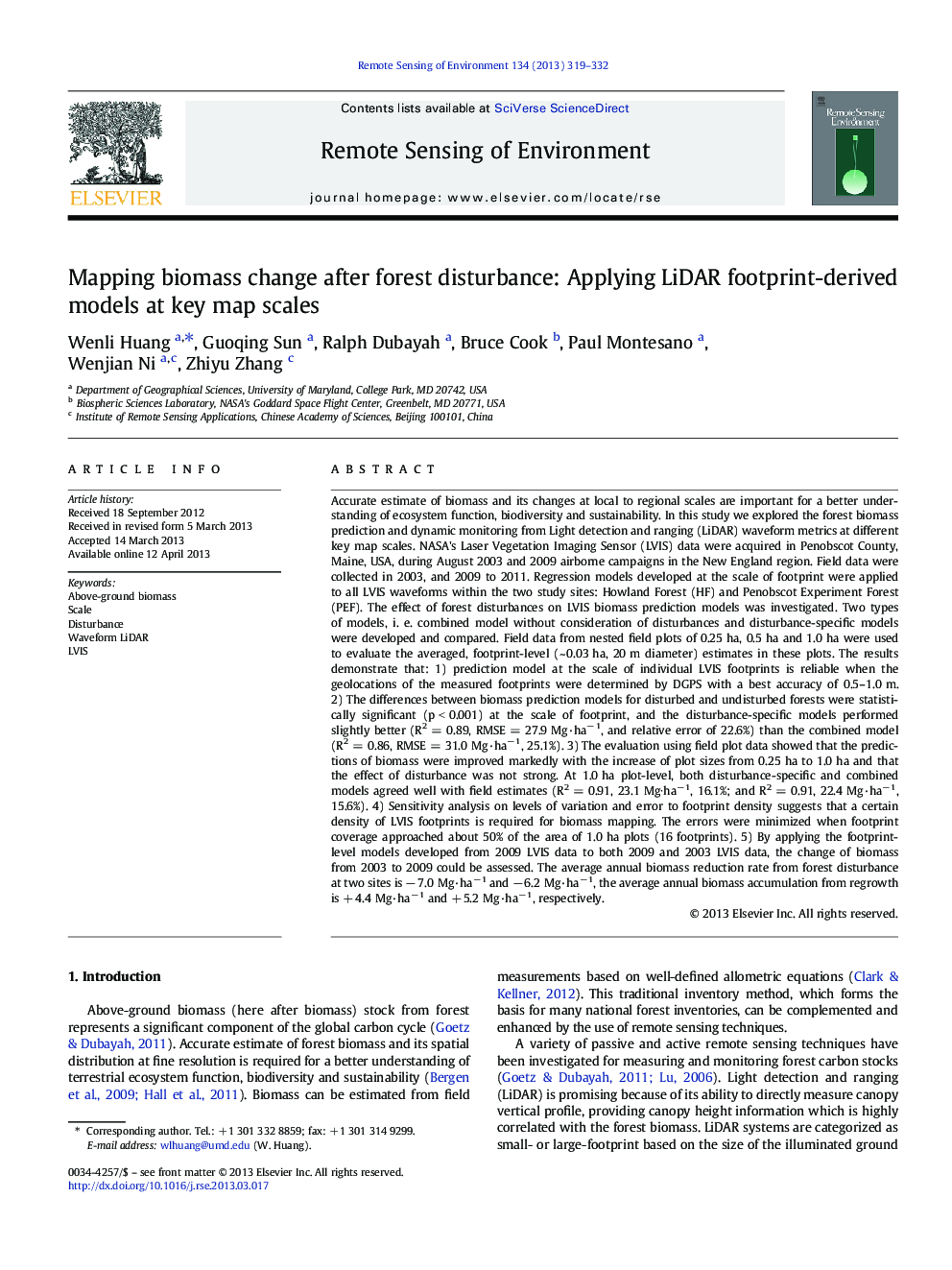| کد مقاله | کد نشریه | سال انتشار | مقاله انگلیسی | نسخه تمام متن |
|---|---|---|---|---|
| 4459181 | 1621266 | 2013 | 14 صفحه PDF | دانلود رایگان |

• We developed above-ground biomass prediction models at LiDAR footprint-level.
• Disturbance-specific models were significant different at footprint-level.
• Evaluation of models indicated an improved accuracy with increasing plot sizes.
• Prediction errors were minimized when footprint coverage approached ~ 50%.
• Footprint-derived model was applied to access the change of biomass at 1.0 ha.
Accurate estimate of biomass and its changes at local to regional scales are important for a better understanding of ecosystem function, biodiversity and sustainability. In this study we explored the forest biomass prediction and dynamic monitoring from Light detection and ranging (LiDAR) waveform metrics at different key map scales. NASA's Laser Vegetation Imaging Sensor (LVIS) data were acquired in Penobscot County, Maine, USA, during August 2003 and 2009 airborne campaigns in the New England region. Field data were collected in 2003, and 2009 to 2011. Regression models developed at the scale of footprint were applied to all LVIS waveforms within the two study sites: Howland Forest (HF) and Penobscot Experiment Forest (PEF). The effect of forest disturbances on LVIS biomass prediction models was investigated. Two types of models, i. e. combined model without consideration of disturbances and disturbance-specific models were developed and compared. Field data from nested field plots of 0.25 ha, 0.5 ha and 1.0 ha were used to evaluate the averaged, footprint-level (~ 0.03 ha, 20 m diameter) estimates in these plots. The results demonstrate that: 1) prediction model at the scale of individual LVIS footprints is reliable when the geolocations of the measured footprints were determined by DGPS with a best accuracy of 0.5–1.0 m. 2) The differences between biomass prediction models for disturbed and undisturbed forests were statistically significant (p < 0.001) at the scale of footprint, and the disturbance-specific models performed slightly better (R2 = 0.89, RMSE = 27.9 Mg·ha− 1, and relative error of 22.6%) than the combined model (R2 = 0.86, RMSE = 31.0 Mg·ha− 1, 25.1%). 3) The evaluation using field plot data showed that the predictions of biomass were improved markedly with the increase of plot sizes from 0.25 ha to 1.0 ha and that the effect of disturbance was not strong. At 1.0 ha plot-level, both disturbance-specific and combined models agreed well with field estimates (R2 = 0.91, 23.1 Mg∙ha− 1, 16.1%; and R2 = 0.91, 22.4 Mg·ha− 1, 15.6%). 4) Sensitivity analysis on levels of variation and error to footprint density suggests that a certain density of LVIS footprints is required for biomass mapping. The errors were minimized when footprint coverage approached about 50% of the area of 1.0 ha plots (16 footprints). 5) By applying the footprint-level models developed from 2009 LVIS data to both 2009 and 2003 LVIS data, the change of biomass from 2003 to 2009 could be assessed. The average annual biomass reduction rate from forest disturbance at two sites is − 7.0 Mg·ha− 1 and − 6.2 Mg·ha− 1, the average annual biomass accumulation from regrowth is + 4.4 Mg·ha− 1 and + 5.2 Mg·ha− 1, respectively.
Journal: Remote Sensing of Environment - Volume 134, July 2013, Pages 319–332